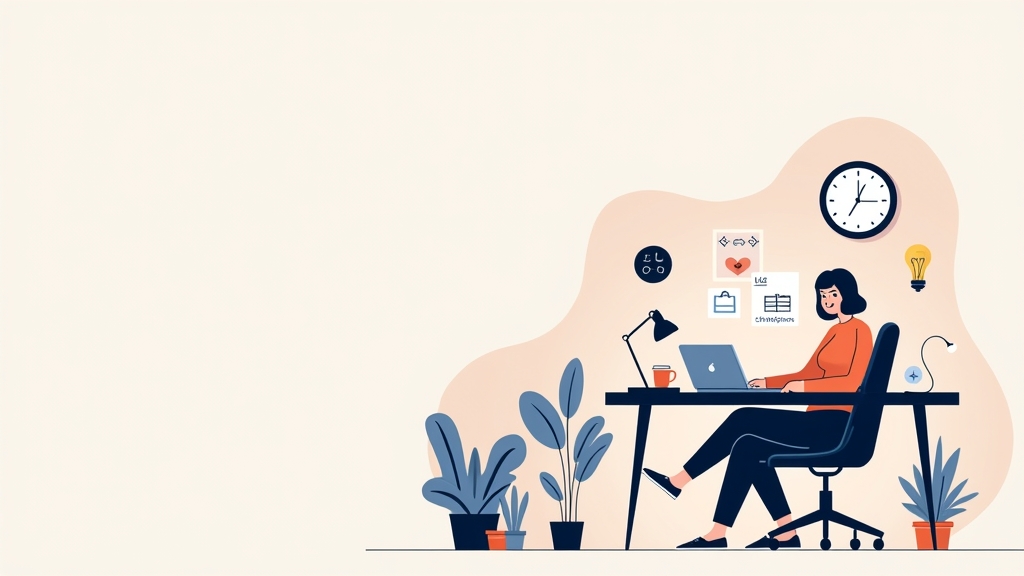The Procrastination Paradox: When Postponing Doesn't Mean Wasting Time
Have you ever found yourself putting off an important task but, in the midst of the distraction, had a brilliant idea to solve another problem? That's no coincidence. Productive procrastination is the art of channeling that impulse to avoid something to generate results in other areas. The secret lies in turning evasion into movementeven if it's not the move you originally planned.
Why does this work? When faced with a challenging task, our brain looks for less painful alternatives. Instead of fighting this tendency, we can redirect it. Imagine you need to write a complex report, but you feel enormous resistance. Instead of pushing it, you decide to organize your inbox. Surprisingly, this "minor" activity frees your mind to mentally structure the report while doing something useful.
Studies in cognitive psychology suggest that secondary tasks activate different neural networks, allowing solutions to emerge indirectly. A classic example is the mathematician Henri Poincaré, who discovered a revolutionary formula while getting off a bus, after weeks of procrastinating on his main job. The key is not to fall into the trap of pure idlenessbut rather in activities that have intrinsic value.
How can you apply this in your daily life? List "minor" tasks that are still productive: reading articles in your field, cleaning your desk, or sketching out ideas for future projects. When resistance hits, refer to this list. This way, you can keep your productivity flowing, even when your main focus seems insurmountable.
Identifying Your Type of Procrastination: Enemy or Ally?
Not all procrastination is the same. Sometimes we procrastinate out of fear of failure, sometimes out of sheer lack of interest. But what if you discovered that your pattern of procrastination was hiding an opportunity? The first step is to classify your procrastinationIs it avoidance due to anxiety or an unconscious search for a more creative path?
Think about the last time you procrastinated. What did you do instead of the main task? If it was mindlessly scrolling social media, maybe it's time to rethink. Now, if you took up a hobby or learned something new, this could be a sign that your brain was looking for a different stimulus so that it could then get back to work more clearly.
Advertising
A useful exercise is to keep a "procrastination diary" for a week. Write down what you were supposed to do, what you did instead and how you felt afterwards. Patterns will emerge: perhaps you avoid bureaucratic tasks, but throw yourself into creative activities. This isn't a defect - it's a map of your natural energy flow. Use these insights to reorganize your schedule, putting creative tasks in the moments of greatest resistance.
For example, a graphic designer who procrastinates on boring clients can use that time to create personal pieces. In the end, this not only keeps their skills sharp, but can also generate a more attractive portfolio. Procrastination becomes a strategy when you understand your rhythm.
Strategies for Turning Wasted Time into Creative Gains
Now that you know that procrastinating can be useful, how can you do it intentionally? The answer lies in structure your alternatives. Instead of leaving distraction to chance, create a menu of productive options that can be triggered when the urge to run away arises.
An effective technique is the "2-minute rule": if you can't get started on a task, do something that takes two minutes or less and is related to it. Need to write a text but are stuck? Write down three quick topics. This breaks inertia and often leads to greater engagement. Another approach is "incubation time": dedicate 15 minutes to a side task before returning to the main project. You may be surprised at the connections that emerge.
Tools such as [Trello] or [Notion] help organize these "planned escapes". Create a board with categories such as "Quick Tasks", "Learning" or "Loose Ideas". When procrastination hits, choose one of these options instead of falling into the void of social media.
A real case: a writer who was struggling to finish her book started translating poems in times of blockage. Not only did this keep her mind active, it also enriched her style. Productivity is not always about the end goal, but about maintaining momentum.
The Role of Self-Knowledge: When Stopping is More Important than Continuing
How many times have you insisted on a task even though you knew it wasn't working? Productive procrastination also involves recognizing when inaction is a sign of exhaustionnot laziness. Our brain has limits, and pushing it beyond them only leads to mediocre work.
Try taking a strategic break. If you've been trying to solve a problem for hours with no progress, stop. Go for a walk, listen to music or do something manual. These activities activate the brain's diffuse mode, which is responsible for creative insights. That's how chemist August Kekulé discovered the structure of benzene - by dreaming of a snake biting its tail.

One proven technique is the [Pomodoro method](https://francescocirillo.com/pages/pomodoro-technique), which alternates periods of focus with short breaks. But go further: use the breaks for activities that stimulate your creative side, such as drawing or playing an instrument. The aim is to get out of the linear mode of thinking.
Ask yourself: "What are my body and mind trying to tell me?" If you constantly procrastinate on a task, perhaps it needs to be rethought, delegated or even abandoned. Sometimes the best course of action is not to act - but with awareness.
Creating Positive Triggers: Link Procrastination to Useful Habits
How about turning procrastination into a productive ritual? The secret lies in associate the desire to postpone with actions that generate value. For example, if you always check your cell phone when avoiding work, replace this habit with a quick read of a relevant article.
An effective method is "habit stacking": after [X action you already do], I'm going to [Y productive action]. For example: "After opening the browser to procrastinate, I'm going to read a chapter of my digital book". Over time, your brain will link the distraction impulse to something constructive.
Apps like [Forest](https://www.forestapp.cc/) or [Freedom](https://freedom.to/) can help by blocking out distractions and suggesting alternatives. But the real change comes from repetition. Start with small goals: swap 10 minutes of social media for 10 minutes of an online course.
One interesting story is that of a programmer who trained himself to review old code whenever he procrastinated. Within a year, this turned into a library of solutions that saved hours of work. What was evasion has become expertise.
When Procrastination Becomes a Problem: Warning Signs and How to Reverse It
Of course, there is a line between productive procrastination and self-sabotage. How do you know if you've crossed the line? Look out for three signsessential tasks always left to the last minute, constant feelings of guilt and negative impacts on long-term goals.
If you realize that you're using "productive" activities only to mask your fear of tackling the main thing, it's time to adjust course. Techniques such as [time blocking](https://calendar.google.com/) can help: set aside specific blocks for focused work and others for "permitted procrastination" activities.
Another warning is decision fatigue. If you spend more time choosing what to do than actually doing it, simplify. Have a pre-defined list of acceptable tasks for moments of resistance. And, if necessary, seek professional help - chronic procrastination can be linked to ADHD or anxiety.
Remember: the goal is not to eliminate procrastination, but to tame it. Even Leonardo da Vinci left works unfinished - but used that time to generate innovations in other areas.
Integrating Productive Procrastination into Your Lifestyle
Now that you have the tools, how do you make it a lasting habit? The answer lies in structured flexibility. Monitor your energy cycles: are there times of day when you are most creative? Reserve them for complex tasks and use the off-peak times for "positive procrastination" activities.
Create a reward system. If you've used your avoidance time well (studying instead of bingeing), allow yourself a small reward. This reinforces the desired behavior. Tools like [Habitica](https://habitica.com/) gamify this process, turning productivity into a game.
Finally, share your method. Talk to colleagues about how they turn procrastination into action. You can discover new techniques and create a network of mutual responsibility.
In the end, mastering productive procrastination is about trusting your rhythm. Instead of blaming yourself for procrastinating, ask: "How can I make this time useful?" The answer could be the key to more fluid creativity and more satisfying work. How about starting today - or tomorrow, if you're more productive?


